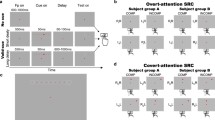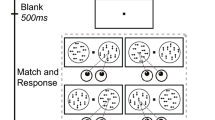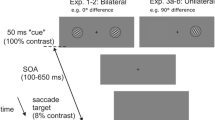Abstract
Covert shifts of attention are usually reflected in RT differences between responses to valid and invalid cues in the Posner spatial attention task. Such inferences about covert shifts of attention do not control for microsaccades in the cue-target interval. We analyzed the effects of microsaccade orientation on RTs in four conditions, crossing peripheral visual and auditory cues with peripheral visual and auditory discrimination targets. Reaction time was generally faster on trials without microsaccades in the cue-target interval. If microsaccades occurred, the target-location congruency of the last microsaccade in the cue-target interval interacted in a complex way with cue validity. For valid visual cues, irrespective of whether the discrimination target was visual or auditory, target-congruent microsaccades delayed RT. For invalid cues, target-incongruent microsaccades facilitated RTs for visual target discrimination but delayed RT for auditory target discrimination. No reliable effects on RT were associated with auditory cues or with the first microsaccade in the cue-target interval. We discuss theoretical implications on the relation about spatial attention and oculomotor processes.




Similar content being viewed by others
References
Baayen, R. H. (2008). Practical data analysis for the language sciences with R. Cambridge: Cambridge University Press.
Barlow, H. B. (1952). Eye movements during fixation. Journal of Physiology, 116, 290–306.
Bates, D. (2008). lme4: Linear mixed-effect models using S4 classes. R package version 0.999375–1 [Software]. Vienna: R Foundation for Statistical Computing.
Betta, E., Galfano, G., & Turatto, M. (2007). Microsaccadic response during inhibition of return in a target-target paradigm. Vision Research, 47, 428–436.
Betta, E., & Turatto, M. (2006). Are you ready? I can tell by looking at your microsaccades. Neuroreport, 17, 1001–1004.
Clowes, M. B. (1962). A note on colour discrimination under conditions of retinal image constraint. Optica Acta, 9, 65–68.
Deubel, H., & Elsner, T. (1986). Threshold perception and saccadic eye movements. Biological Cybernetics, 54, 351–358.
Ditchburn, R. W. (1955). Eye-movements in relation to retinal action. Optica Acta, 1, 171–176.
Ditchburn, R. W. (1980). The function of small saccades. Vision Research, 20, 271–272.
Ditchburn, R. W., & Ginsborg, B. L. (1953). Involuntary eye movements during fixation. Journal of Physiology, 119, 1–17.
Donner, K., & Hemilä, S. (2007). Modelling the effect of microsaccades on retinal responses to stationary contrast patterns. Vision Research, 47, 1166–1177.
Elsner, T., & Deubel, H. (1986). The effect of saccades on threshold perception—A model study. Biological Cybernetics, 54, 359–366.
Engbert, R. (2006). Microsaccades: A microcosm for research on oculomotor control, attention, and visual perception. Progress in Brain Research, 154, 177–192.
Engbert, R., & Kliegl, R. (2003). Microsaccades uncover the orientation of covert attention. Vision Research, 43, 1035–1045.
Engbert, R., & Mergenthaler, K. (2006). Microsaccades are triggered by low retinal image slip. Proceedings of the National Academy of Sciences of the United States of America, 103, 7192–7197.
Galfano, G., Betta, E., & Turatto, M. (2004). Inhibition of return in microsaccades. Experimental Brain Research, 159, 400–404.
Gerrits, H. J. M., & Vendrik, A. J. H. (1974). The influence of stimulus movements on perception in parafoveal stabilized vision. Vision Research, 14, 175–180.
Hafed, Z. M., & Clark, J. J. (2002). Microsaccades as an overt measure of covert attention shifts. Vision Research, 42, 2533–2545.
Horowitz, T. S., Fine, E. M., Fencsik, D. E., Yurgenson, S., & Wolfe, J. M. (2007a). Fixational eye movements are not an index of covert attention. Psychological Science, 18, 356–363.
Horowitz, T. S., Fencsik, D. E., Fine, E. M., Yurgenson, S., & Wolfe, J. M. (2007b). Microsaccades and attention: Does a weak correlation make an index? Reply to Laubrock, Engbert, Rolfs, & Kliegl (2007). Psychological Science, 18, 367–368.
Kliegl, R. (2007). Towards a perceptual-span theory of distributed processing in reading: A reply to Rayner, Pollatsek, Drieghe, Slattery, & Reichle (2007). Journal of Experimental Psychology. General, 138, 530–537.
Kliegl, R., Risse, S., & Laubrock, J. (2007). Preview benefit and parafoveal-on-foveal effects from word n + 2. Journal of Experimental Psychology: Human Perception and Performance, 33, 1250–1255.
Krummenacher, J., Müller, H.J., & Geyer, T. (2008). RT performance in visual search is affected by dimension- and space-based intertribal contingencies. Psychological Research.
Laubrock, J., Engbert, R., & Kliegl, R. (2005). Microsaccade dynamics during covert attention. Vision Research, 45, 721–730.
Laubrock, J., Engbert, R., & Kliegl, R. (2008). Fixational eye movements predict the perceived direction of ambiguous apparent motion. Journal of Vision, 8(14), 1–17.
Laubrock, J., Engbert, R., Rolfs, M., & Kliegl, R. (2007). Microsaccades are an index of covert attention. Commentary on Horowitz, Fine, Fencsik, Yurgenson, and Wolfe (2007). Psychological Science, 18, 364–366.
Martinez-Conde, S., Macknik, S. L., Troncoso, X. G., & Dyar, T. A. (2006). Microsaccades counteract visual fading during fixation. Neuron, 49, 297–305.
Müller, H. J., & Rabbitt, P. M. (1989). Reflexive and voluntary orienting of visual attention: Time course of activation and resistance to interruption. Journal of Experimental Psychology: Human Perception and Performance, 15, 315–330.
Pinheiro, J., & Bates, D. (2000). Mixed-effects models in S and S-Plus. New York: Springer.
Posner, M. I. (1980). Orientation of attention. The VIIth Sir Frederic Bartlett lecture. Quarterly Journal of Experimental Psychology, 32A, 3–25.
Posner, M. I., & Cohen, Y. (1984). Components of visual orienting. In H. Bouma & D. G. Bouwhuis (Eds.), Attention and Performance, X (pp. 531–556). Hillsdale: Erlbaum.
Posner, M. I., Davidson, B. J., & Snyder, C. R. R. (1980). Attention and the detection of signals. Journal of Experimental Psychology. General, 109, 160–174.
Quené, H., & van den Bergh, H. (2004). On multi-level modeling of data from repeated measures designs: A tutorial. Speech Communication, 43, 103–121.
R Development Core Team (2007). R: A language and environment for statistical computing. R Foundation for Statistical Computing, Vienna, Austria. ISBN 3-900051-07-0, URL http://www.R-project.org.
Ratliff, F., & Riggs, L. A. (1950). Involuntary motions of the eye during monocular fixation. Journal of Experimental Psychology, 40, 687–701.
Rattle, J. D., & Foley-Fisher, J. A. (1968). A relationship between vernier acuity and intersaccadic interval. Optica Acta, 15, 617–620.
Rolfs, M., Engbert, R., & Kliegl, R. (2004). Microsaccade orientation supports attentional enhancement opposite a peripheral cue. Psychological Science, 15, 705–707.
Rolfs, M., Engbert, R., & Kliegl, R. (2005). Crossmodal coupling of oculomotor control and spatial attention in vision and audition. Experimental Brain Research, 166, 427–439.
Rolfs, M., Kliegl, R., & Engbert, R. (2008). Toward a model of microsaccade generation: The case of microsaccadic inhibition. Journal of Vision, 8(11), 1–23.
Rolfs, M., Laubrock, J., & Kliegl, R. (2008). Microsaccade-induced prolongation of saccadic latencies depends on microsaccade amplitude. Journal of Eye Movement Research, 1(3), 1–8.
Rolfs, M., Laubrock, J., & Kliegl, R. (2006). Shortening and prolongation of saccade latencies following microsaccades. Experimental Brain Research, 169, 369–376.
Tse, P. U., Sheinberg, D. L., & Logothetis, N. K. (2002). Fixational eye movements are not affected by abrupt onsets that capture attention. Vision Research, 42, 1663–1669.
Tse, P. U., Sheinberg, D. L., & Logothetis, N. K. (2003). Attentional enhancement opposite a peripheral flash revealed using change blindness. Psychological Science, 14, 91–99.
Tse, P. U., Sheinberg, D. L., & Logothetis, N. K. (2004). The distribution of microsaccade directions need not reveal the location of attention. Psychological Science, 15, 708–710.
Wickham, H. (2007a). Reshaping data with the reshape package. Journal of Statistical Software, 21,1–19. [Software] R package version 0.8.0.
Wickham, H. (2007b). ggplot2: An implementation of the grammar of graphics. [Software] R package version 0.5.7. http://had.co.nz/ggplot2/.
Zuber, B. L., & Stark, L. (1966). Saccadic suppression: Elevation of visual threshold associated with saccadic eye movements. Experimental Neurology, 16, 65–79.
Acknowledgments
This research was supported by Deutsche Forschungsgemeinschaft (grants KL-955/3 and KL/955-6). Data and R-scripts are available upon request. We thank Erich Schröger and a reviewer for helpful comments.
Author information
Authors and Affiliations
Corresponding author
Rights and permissions
About this article
Cite this article
Kliegl, R., Rolfs, M., Laubrock, J. et al. Microsaccadic modulation of response times in spatial attention tasks. Psychological Research 73, 136–146 (2009). https://doi.org/10.1007/s00426-008-0202-2
Received:
Accepted:
Published:
Issue Date:
DOI: https://doi.org/10.1007/s00426-008-0202-2




